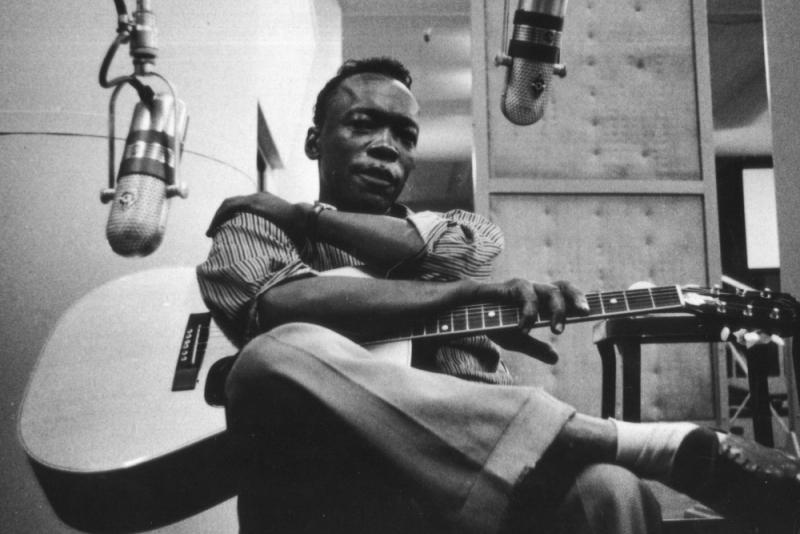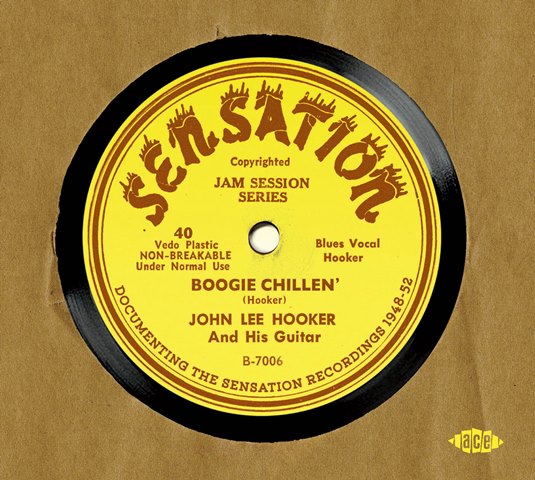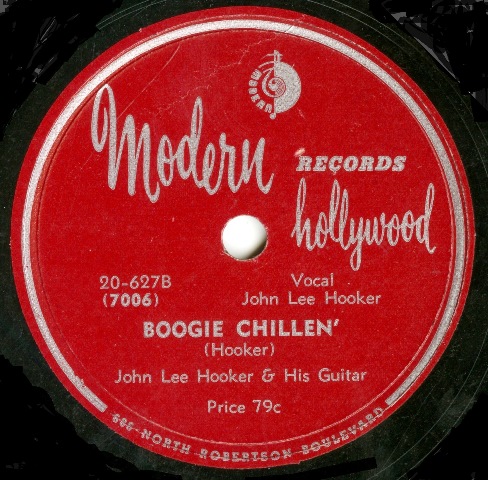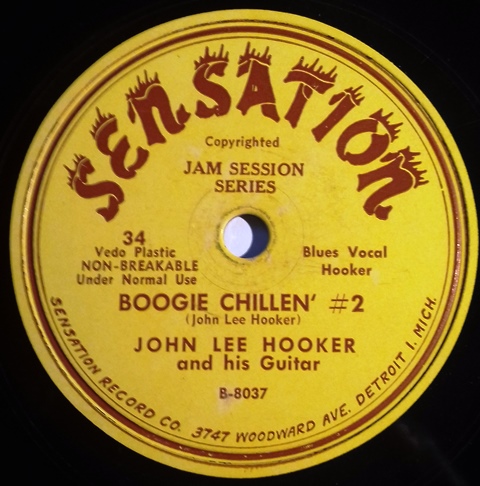Reissue CDs Weekly: John Lee Hooker - Documenting The Sensation Recordings 1948-1952 | reviews, news & interviews
Reissue CDs Weekly: John Lee Hooker - Documenting The Sensation Recordings 1948-1952
Reissue CDs Weekly: John Lee Hooker - Documenting The Sensation Recordings 1948-1952
Definitive chronicle of the legendary blues-man’s earliest recording sessions

John Lee Hooker’s recording career began on Friday 3 September 1948. He’d attracted the attention of the Kiev-born Bernard Besman, who was in Detroit after his family moved there in 1926 following five years in London’s East End. By the 1940s Besman, who played piano, was a veteran of dance bands and also worked as a booker.
Hooker was another transplant to Detroit. Born in Mississippi, he had lived in Memphis and arrived in Detroit in 1943. He played live, but earned a wage at the Ford factory and then at a steel mill. Before meeting Besman, a local record shop owner arranged for him to record demos.
 The most immediate result of the session with Besman booked at Detroit’s United Sound studios was the release of the "Boogie Chillen'" / "Sally May" single, which Sensation leased to California’s Modern label. The single would, in 1949, become a best seller. Modern went on to issue other tracks from the session on subsequent singles: “Crawlin' King Snake”, “Drifting From Door to Door”, “Hobo Blues” and “Howlin' Wolf”. Unsurprisingly, in the wake of Hooker's success, further tracks and alternate versions from the September 1948 session surfaced on a haphazard series of albums.
The most immediate result of the session with Besman booked at Detroit’s United Sound studios was the release of the "Boogie Chillen'" / "Sally May" single, which Sensation leased to California’s Modern label. The single would, in 1949, become a best seller. Modern went on to issue other tracks from the session on subsequent singles: “Crawlin' King Snake”, “Drifting From Door to Door”, “Hobo Blues” and “Howlin' Wolf”. Unsurprisingly, in the wake of Hooker's success, further tracks and alternate versions from the September 1948 session surfaced on a haphazard series of albums.
That Friday at United Sound was epochal. “Boogie Chillen'" became one of the standard candidates for the slippery role of the first rock ’n roll record. “Crawlin' King Snake” would live forever and has been covered endlessly. The first 13 tracks on the important 3-CD set Documenting The Sensation Recordings 1948–1952 bring together everything which is now known to survive from the session (the cover image, pictured above, is a fun mock-up of what a Sensation release of "Boogie Chillen'" would have looked like). Astoundingly, amongst this baker’s dozen is a trio of previously unheard performances: three radically different takes of “War is Over (Goodbye California)”.
Documenting The Sensation Recordings 1948–1952 is, manifestly, a major release. It collects for the first time everything Hooker recorded with Besman – the period before the singer-guitarist-writer’s hook-up with Chess Records. Hooker’s attitude to contracts was loose, and his pseudonymous Besman-era recordings for other labels made as Delta John, Texas Slim and Johnny Williams are absent as they had nothing to with Sensation. A Besman-produced Little Eddie Kirkland single with John Lee Hooker on guitar and vocal is included,
 This collection is issued by Ace Records, who bought the Sensation catalogue from Besman (he died in 2003). Ace also has the rights for Besman’s licensee Modern. Documenting The Sensation Recordings is the result of a recent, thorough examination of what came with the two acquisitions. The audio sources include newly discovered acetates and previously undocumented tracks lurking on master tapes. The sound quality is, maybe surprisingly, great. Nothing evidences digital over processing. The well-annotated booklet inside the slipcase with the 3-CD digi-pack includes illustrations of the acetates, tape boxes and studio logs, a sessionography as well as commentaries by Dr Wayne Goins of Kansas State University and Peter Guralnick.
This collection is issued by Ace Records, who bought the Sensation catalogue from Besman (he died in 2003). Ace also has the rights for Besman’s licensee Modern. Documenting The Sensation Recordings is the result of a recent, thorough examination of what came with the two acquisitions. The audio sources include newly discovered acetates and previously undocumented tracks lurking on master tapes. The sound quality is, maybe surprisingly, great. Nothing evidences digital over processing. The well-annotated booklet inside the slipcase with the 3-CD digi-pack includes illustrations of the acetates, tape boxes and studio logs, a sessionography as well as commentaries by Dr Wayne Goins of Kansas State University and Peter Guralnick.
Overall, there are 82 tracks. Nineteen of them are previously unreleased versions. Eleven sessions are heard, sequenced in chronological order. Hooker’s final studio session with Besman was held on 22 May 1952. Incredibly, what’s heard from the date includes "That's All Right Boogie", a track with Kirkland which has never previously surfaced.
Especially interesting is a 10-track session from 28 April 1950. By this time, thanks to “Boogie Chillen'", Hooker was nationally known. Five of the tracks are versions of “Boogie Chillen' #2”, a cut Sensation itself issued and maybe asked Hooker to create – doubtless in an attempt catch up with Modern making hay with “Boogie Chillen'”. Of the versions of “Boogie Chillen' #2”, Take 1 has never been heard before. Two takes appear for the first time in an unedited, extended form.
 Considering that “Boogie Chillen' #2” is a livelier sibling of “Boogie Chillen'", it’s unsurprising Hooker messes around from one take to the next. The third version has a different, more boompity-boomp rhythm than its predecessors. The final run-through incorporates unique guitar flurries and ostensibly off-the-cuff lyrics. Hooker wasn’t playing the same thing twice. Commercial success had not turned him into a human jukebox.
Considering that “Boogie Chillen' #2” is a livelier sibling of “Boogie Chillen'", it’s unsurprising Hooker messes around from one take to the next. The third version has a different, more boompity-boomp rhythm than its predecessors. The final run-through incorporates unique guitar flurries and ostensibly off-the-cuff lyrics. Hooker wasn’t playing the same thing twice. Commercial success had not turned him into a human jukebox.
Also from this session, “Roll ’n Roll” (another previously unheard take) quirkily re-uses the “Boogie Chillen'" rhythm and raises the question of what level of preparation went into each studio visit. Next up, “Rollin' Blues” is pretty much the same song as “Roll ’n Roll”. Again, off-the-cuff appears right.
It’s exciting to hear John Lee Hooker finding and feeling his way. Although assured, he wasn’t paying heed to exactitude. Besman wasn’t setting templates. Also, while everything collected does not strictly foretell what lay ahead – these aren’t musical tea leaves which can be read to tell Hooker’s future – it feeds into it. Laying-out this opening chapter of Hooker's recording career so boldly tells a previously untold history. The great music is reason enough reason to get this, but anyone with the barest interest in the development of blues and how it was co-opted by white pop needs Documenting The Sensation Recordings 1948–1952.
- Next Week: Bonus-stuffed reissue of the Brian Wilson and Van Dyke Parks album Orange Crate Art
- More reissue reviews on theartsdesk
- Kieron Tyler’s website
Share this article
Add comment
The future of Arts Journalism
You can stop theartsdesk.com closing!
We urgently need financing to survive. Our fundraising drive has thus far raised £49,000 but we need to reach £100,000 or we will be forced to close. Please contribute here: https://gofund.me/c3f6033d
And if you can forward this information to anyone who might assist, we’d be grateful.

Subscribe to theartsdesk.com
Thank you for continuing to read our work on theartsdesk.com. For unlimited access to every article in its entirety, including our archive of more than 15,000 pieces, we're asking for £5 per month or £40 per year. We feel it's a very good deal, and hope you do too.
To take a subscription now simply click here.
And if you're looking for that extra gift for a friend or family member, why not treat them to a theartsdesk.com gift subscription?
more New music
 'The Art of Loving': Olivia Dean's vulnerable and intimate second album
Neo soul Londoner's new release outgrows her debut
'The Art of Loving': Olivia Dean's vulnerable and intimate second album
Neo soul Londoner's new release outgrows her debut
 Music Reissues Weekly: The Peanut Butter Conspiracy - The Most Up Till Now
Definitive box-set celebration of the Sixties California hippie-pop band
Music Reissues Weekly: The Peanut Butter Conspiracy - The Most Up Till Now
Definitive box-set celebration of the Sixties California hippie-pop band
 Doja Cat's 'Vie' starts well but soon tails off
While it contains a few goodies, much of the US star's latest album lacks oomph
Doja Cat's 'Vie' starts well but soon tails off
While it contains a few goodies, much of the US star's latest album lacks oomph
 Mariah Carey is still 'Here for It All' after an eight-year break
Schmaltz aplenty but also stunning musicianship from the enduring diva
Mariah Carey is still 'Here for It All' after an eight-year break
Schmaltz aplenty but also stunning musicianship from the enduring diva
 Album: Solar Eyes - Live Freaky! Die Freaky!
Psychedelic indie dance music with a twinkle in its eye
Album: Solar Eyes - Live Freaky! Die Freaky!
Psychedelic indie dance music with a twinkle in its eye
 Album: Night Tapes - portals//polarities
Estonian-voiced, London-based electro-popsters' debut album marks them as one to watch for
Album: Night Tapes - portals//polarities
Estonian-voiced, London-based electro-popsters' debut album marks them as one to watch for
 Album: Mulatu Astatke - Mulatu Plays Mulatu
An album full of life, coinciding with a 'farewell tour'
Album: Mulatu Astatke - Mulatu Plays Mulatu
An album full of life, coinciding with a 'farewell tour'
 Music Reissues Weekly: Sly and the Family Stone - The First Family: Live At Winchester Cathedral 1967
Must-have, first-ever release of the earliest document of the legendary soul outfit
Music Reissues Weekly: Sly and the Family Stone - The First Family: Live At Winchester Cathedral 1967
Must-have, first-ever release of the earliest document of the legendary soul outfit
 Album: Robert Plant - Saving Grace
Mellow delight from former Zep lead
Album: Robert Plant - Saving Grace
Mellow delight from former Zep lead
 Brìghde Chaimbeul, Round Chapel review - enchantment in East London
Inscrutable purveyor of experimental Celtic music summons creepiness and intensity
Brìghde Chaimbeul, Round Chapel review - enchantment in East London
Inscrutable purveyor of experimental Celtic music summons creepiness and intensity
 Album: NewDad - Altar
The hard-gigging trio yearns for old Ireland – and blasts music biz exploitation
Album: NewDad - Altar
The hard-gigging trio yearns for old Ireland – and blasts music biz exploitation
 First Person: Musician ALA.NI on how thoughts of empire and reparation influenced a song
She usually sings about affairs of the heart - 'TIEF' is different, explains the star
First Person: Musician ALA.NI on how thoughts of empire and reparation influenced a song
She usually sings about affairs of the heart - 'TIEF' is different, explains the star

Comments
The last line offends me.
I’m thoroughly enjoying